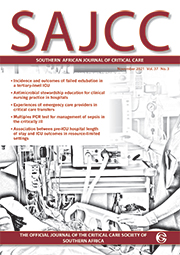Articles

Spectrum of microbial growth and antimicrobial usage in an intensive-care unit of a tertiary-care hospital in Trinidad, West Indies
Abstract
Background. Intensive-care units (ICUs) are a source of multidrug-resistant organisms, owing to the indiscriminate usage of broad-spectrum antimicrobial drugs. In such settings, one must be aware of the spectrum of microbes and pattern of antibiotic usage.
Objectives. To evaluate the spectrum, susceptibility and resistance patterns of microbes found in ICU patients in a tertiary-care teaching hospital in Trinidad, and to quantify antimicrobial usage.
Methods. All adult patients (≥15 years of age) admitted to the ICU for ≥48 h who developed nosocomial infections conforming to the Centers for Disease Control and Prevention criteria were included. Demographic data and clinical data, including specimens sent, isolates grown, antimicrobial sensitivity and resistance patterns, the usage of antimicrobials and patient outcomes, were recorded. Variables such as age, admission white blood cell count, duration of first antibiotic used, length of ICU stay, length of hospital stay, organ support and total comorbidities were analysed. Antimicrobial usage was quantified as the defined daily dosage per 1 000 patient-days.
Results. A total of 153 patients with 287 microbiological specimens were studied. The mean patient age was 48.4 years, and the mean ICU length of stay was 7.9 days. The most common admitting diagnoses were sepsis and multiple trauma. Staphylococcus aureus was the most common isolate from blood and central venous lines, and Pseudomonas aeruginosa from tracheal aspirates and wound swabs. Non-survivors had significantly higher age, leucocyte count and organ support requirements, and shorter lengths of stay. Cefuroxime was the most-used antimicrobial in the unit.
Conclusion. The usage pattern of antimicrobials did not correlate with susceptibility in most instances. There is a need to improve antimicrobial usage by implementing antimicrobial-stewardship programmes to establish an antimicrobial protocol and guidelines for usage in the ICU.
Authors' affiliations
S Bidaisee, Anaesthesia and Intensive Care Unit, Faculty of Medical Sciences, University of the West Indies, St. Augustine, Trinidad and Tobago
S Hariharan, Anaesthesia and Intensive Care Unit, Faculty of Medical Sciences, University of the West Indies, St. Augustine, Trinidad and Tobago
D Chen, Anaesthesia and Intensive Care Unit, Faculty of Medical Sciences, University of the West Indies, St. Augustine, Trinidad and Tobago
Full Text
Keywords
Cite this article
Article History
Date published: 2017-10-11
Article Views
Full text views: 1283




1.jpg)
Comments on this article
*Read our policy for posting comments here